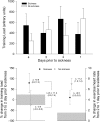Predicting sickness during a 2-week soccer camp at 3600 m (ISA3600)
- PMID: 24282199
- PMCID: PMC3903312
- DOI: 10.1136/bjsports-2013-092757
Predicting sickness during a 2-week soccer camp at 3600 m (ISA3600)
Abstract
Objectives: To examine the time course of changes in wellness and health status markers before and after episodes of sickness in young soccer players during a high-altitude training camp (La Paz, 3600 m).
Methods: Wellness and fatigue were assessed daily on awakening using specifically-designed questionnaires and resting measures of heart rate and heart rate variability. The rating of perceived exertion and heart rate responses to a submaximal run (9 km/h) were also collected during each training session. Players who missed the morning screening for at least two consecutive days were considered as sick.
Results: Four players met the inclusion criteria. With the exception of submaximal exercise heart rate, which showed an almost certain and large increase before the day of sickness (4%; 90% confidence interval 3 to 6), there was no clear change in any of the other psychometric or physiological variables. There was a very likely moderate increase (79%, 22 to 64) in self-reported training load the day before the heart rate increase in sick players (4 of the 4 players, 100%). In contrast, training load was likely and slightly decreased (-24%, -78 to -11) in players who also showed an increased heart rate but remained healthy.
Conclusions: A >4% increased heart rate during submaximal exercise in response to a moderate increase in perceived training load the previous day may be an indicator of sickness the next day. All other variables, that is, resting heart rate, heart rate variability and psychometric questionnaires may be less powerful at predicting sickness.
Keywords: Altitude; Cardiology prevention; Fatigue; Physiology; Soccer.
Figures


Similar articles
-
Wellness, fatigue and physical performance acclimatisation to a 2-week soccer camp at 3600 m (ISA3600).Br J Sports Med. 2013 Dec;47 Suppl 1(Suppl 1):i100-6. doi: 10.1136/bjsports-2013-092749. Br J Sports Med. 2013. PMID: 24282195 Free PMC article.
-
Methods of the international study on soccer at altitude 3600 m (ISA3600).Br J Sports Med. 2013 Dec;47 Suppl 1(Suppl 1):i80-5. doi: 10.1136/bjsports-2013-092770. Br J Sports Med. 2013. PMID: 24282214 Free PMC article.
-
Psychometric and Physiological Responses to a Preseason Competitive Camp in the Heat With a 6-Hour Time Difference in Elite Soccer Players.Int J Sports Physiol Perform. 2016 Mar;11(2):176-81. doi: 10.1123/ijspp.2015-0135. Epub 2015 Jul 13. Int J Sports Physiol Perform. 2016. PMID: 26182437
-
Monitoring training load and fatigue in soccer players with physiological markers.Physiol Behav. 2017 Nov 1;181:86-94. doi: 10.1016/j.physbeh.2017.09.004. Epub 2017 Sep 5. Physiol Behav. 2017. PMID: 28886966 Review.
-
Preparation for football competition at moderate to high altitude.Scand J Med Sci Sports. 2008 Aug;18 Suppl 1:85-95. doi: 10.1111/j.1600-0838.2008.00836.x. Scand J Med Sci Sports. 2008. PMID: 18665956 Review.
Cited by
-
Yin and yang, or peas in a pod? Individual-sport versus team-sport athletes and altitude training.Br J Sports Med. 2013 Dec;47(18):1150-4. doi: 10.1136/bjsports-2013-092764. Br J Sports Med. 2013. PMID: 24255910 Free PMC article. Review.
-
Submaximal Fitness Tests in Team Sports: A Theoretical Framework for Evaluating Physiological State.Sports Med. 2022 Nov;52(11):2605-2626. doi: 10.1007/s40279-022-01712-0. Epub 2022 Jul 11. Sports Med. 2022. PMID: 35817993 Free PMC article. Review.
-
Improving team-sport player's physical performance with altitude training: from beliefs to scientific evidence.Br J Sports Med. 2013 Dec;47 Suppl 1(Suppl 1):i2-3. doi: 10.1136/bjsports-2013-093119. Br J Sports Med. 2013. PMID: 24282201 Free PMC article. No abstract available.
-
Wellness, fatigue and physical performance acclimatisation to a 2-week soccer camp at 3600 m (ISA3600).Br J Sports Med. 2013 Dec;47 Suppl 1(Suppl 1):i100-6. doi: 10.1136/bjsports-2013-092749. Br J Sports Med. 2013. PMID: 24282195 Free PMC article.
-
Monitoring training status with HR measures: do all roads lead to Rome?Front Physiol. 2014 Feb 27;5:73. doi: 10.3389/fphys.2014.00073. eCollection 2014. Front Physiol. 2014. PMID: 24578692 Free PMC article.
References
-
- Billaut F, Gore CJ, Aughey RJ. Enhancing team-sport athlete performance: is altitude training relevant? Sports Med 2012;9:751–67 - PubMed
-
- Millet GP, Roels B, Schmitt L, et al. Combining hypoxic methods for peak performance. Sports Med 2010;1:1–25 - PubMed
-
- Gore CJ, McSharry PE, Hewitt AJ, et al. Preparation for football competition at moderate to high altitude. Scand J Med Sci Sports 2008;18(Suppl 1): 85–95 - PubMed
-
- Bonetti DL, Hopkins WG. Sea-level exercise performance following adaptation to hypoxia: a meta-analysis. Sports Med 2009;2:107–27 - PubMed
-
- Wachsmuth NB, Volzke C, Prommer N, et al. The effects of classic altitude training on hemoglobin mass in swimmers. Eur J Appl Physiol 2013;5:1199–211 - PubMed
MeSH terms
LinkOut - more resources
Full Text Sources
Other Literature Sources
Miscellaneous
